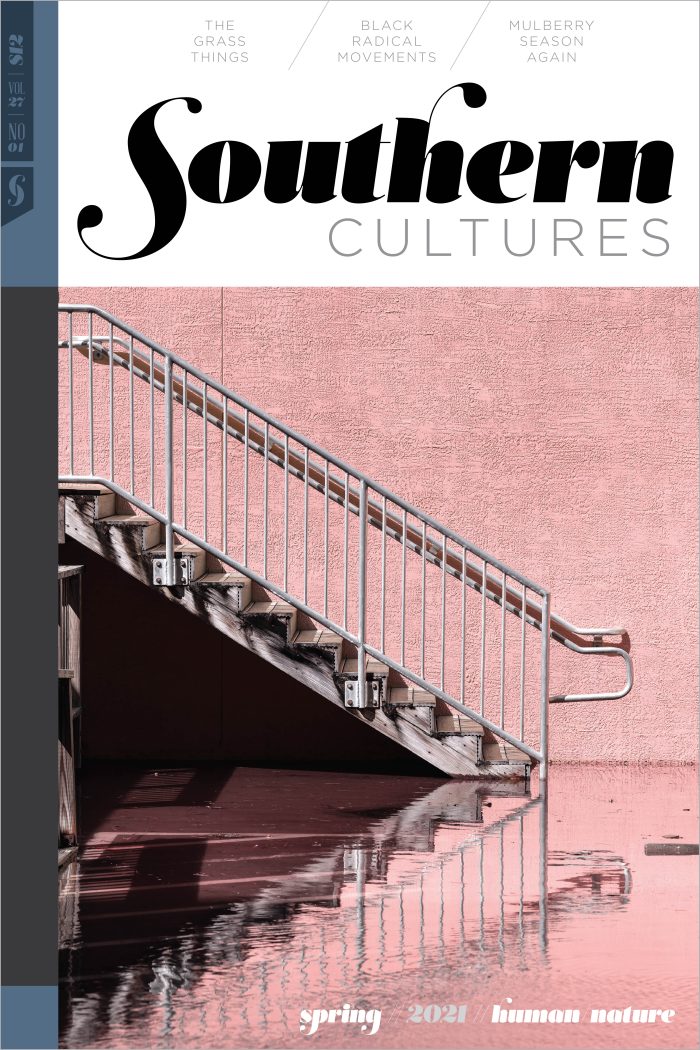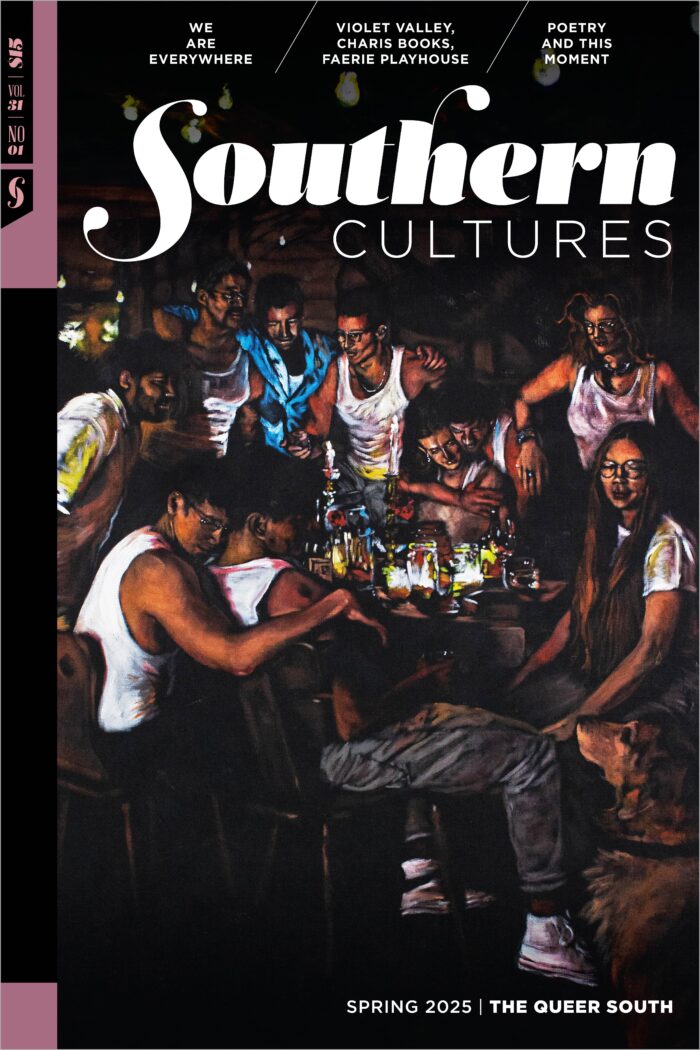In the sweltering summer of 2010, as thousands of barrels of crude oil from the Deepwater Horizon oil rig explosion that April gushed daily into the Gulf of Mexico, sixty-two-year-old Malik Rahim took an unusual course of action. He got on his bike. The New Orleans native and lifelong organizer announced his intention to cycle from southeast Louisiana to Washington, DC, “stopping at state capitals, universities and community centers along the way,” to call attention to the needs of Louisiana’s fragile coastline. Described in a press release as a “novice cyclist but a veteran activist,” Rahim planned to complete his journey in just over two months, inviting “all interested parties to join him on his ride, particularly those with the Green Party and other environmental affiliations.” “Now more than ever, our wetlands need to be rebuilt,” Rahim declared. “We need help!”1
To the casual observer, the imposing former Black Panther’s studied interest in the ecological health of distant marshes and bayous would have appeared a somewhat unlikely proposition. Rahim was a city dweller who had spent his entire life either in New Orleans or the San Francisco Bay Area, other than a period of incarceration. At the time, he was best known for two things: his participation in a harrowing 1970 shootout with the New Orleans Police Department as a member of the Black Panther Party and his work with Common Ground, the expansive grassroots volunteer organization he cofounded in 2005 in the weeks after Hurricane Katrina that delivered critical supplies, gutted houses, and provided free health care to local residents. To his critics, the bicycle journey registered as little more than a publicity stunt or a money-raising scam. But to anyone familiar with the full arc of Rahim’s politics and activist pursuits, both before and after the flooding of his hometown, his ardent wetlands advocacy made perfect sense.
Understanding why someone like Rahim would take up the cause of imperiled wetlands requires reimagining who fits the definition of an “environmentalist.” In the popular imagination, an environmentalist is invariably an earnest, college-educated white person working for a nonprofit organization on behalf of imperiled animals or distant wilderness, seemingly removed from issues of race or class politics. Thus, when the New York Times characterized the oil spill as a “rallying cry” for environmental groups, the newspaper was referring to organizations such as the Sierra Club, American Rivers, and Environment Texas, which were redirecting their fundraising, canvassing, and lobbying efforts from other issues to the Gulf disaster. The “environmentalist” moniker may well have called to mind the Greenpeace activists who grabbed media headlines that spring by staging dramatic protests at bp’s London headquarters and on the side of a ship set to depart Louisiana for a drilling expedition in the Alaskan arctic. These sorts of stories helped solidify popular conceptions of what constitutes legible environmentalism and its primary concerns.2
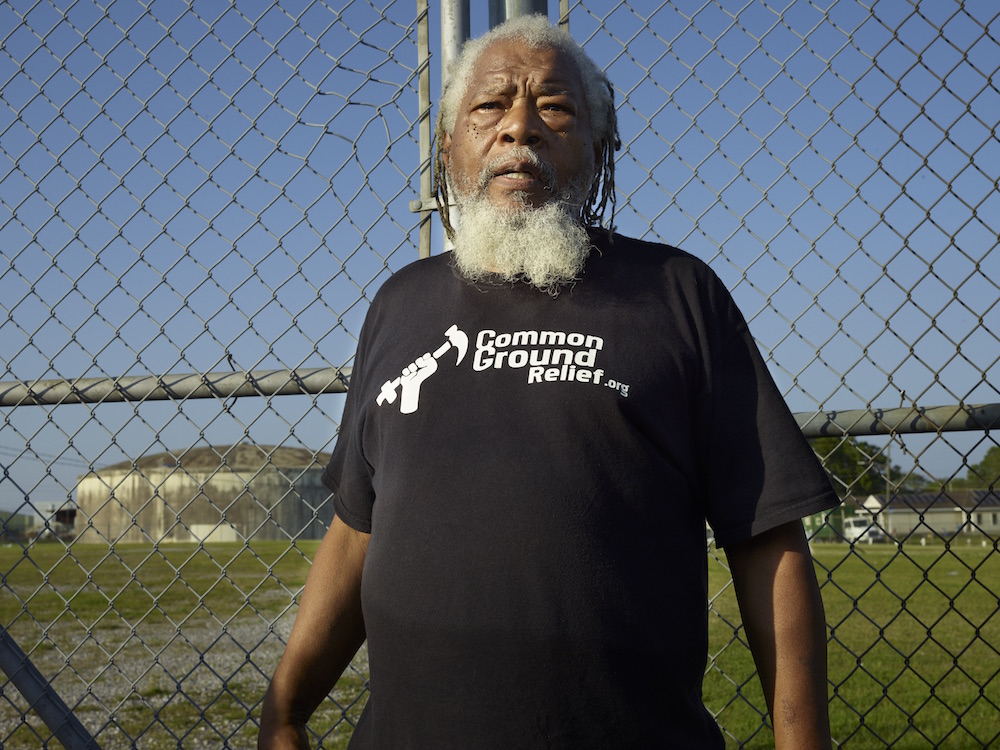
At the same time, they also obscure what interdisciplinary scholar J. T. Roane and anthropologist Justin Hosbey refer to as the “insurgent knowledge” of communities most vulnerable to environmental disaster. As environmental justice scholars and advocates have long contended, often the people most impacted best understand environmental threat and potential remedies. Yet the historic exclusion of Black communities from prevailing representations of environmental advocacy and defense produces what critic Kimberly N. Ruffin characterizes as “an ecological paradox for African Americans.” The racism inflicted on Black people, Ruffin asserts, causes them to “suffer economically and environmentally.” But racism does more than conceal the disproportionate impact of environmental hazards on Black communities. Popular understandings of the natural world—and, by extension, its protection—ignore racism’s pernicious effect. This common perceptual framework thus blinds many observers to both environmental racism and Black environmentalism.3
The solitary bike ride undertaken in the wake of the BP catastrophe, and the story of the man behind it, suggests a different narrative. Taking seriously the environmental thinking and activism of a figure like Malik Rahim illuminates often underappreciated connections between ecological defense and the long Black freedom movement. Tracing Rahim’s influences means following a different set of coordinates on the map of US environmentalism, one in which the Black Panther Party and the Green Party meet, albeit uneasily. Rahim’s life demonstrates the centrality of environmentalism to the linked causes of racial and economic justice. Rahim thus embodies a commitment to thinking about environmental hazard and social inequalities in tandem, an orientation that can be broadly understood as one of “environmental justice.”4
To follow Malik Rahim’s path means engaging with a distinct lineage of Black environmentalism, one that shares many concerns with the mainstream environmental movement but cannot be subsumed under it. In building on the work of scholars such as David Pellow, Laura Pulido, Ruth Wilson Gilmore, and others, we can further call attention to a Black radical tradition within the history of environmentalism, to insist on environmentalism’s place in the history of Black radicalism, and place Rahim within a wider constellation of grassroots environmental activists in Louisiana. Collectively, these figures have sought at once to protect the earth and protect Black people from extractive racial capitalism. If Rahim’s formation as an environmentalist reflects a distinctive set of experiences and influences, he is far from a solitary voice. Instead, Rahim’s story can serve as a useful vantage point from which to appreciate a larger tradition.5
Malik Rahim recognized that the unfolding Deepwater Horizon disaster threatened more than just the Gulf Coast’s fishing industry and tourist destinations. Like many others, he knew the oil spill posed a grave economic peril to a metropolitan area still struggling to recover from the devastating levee breaches five years earlier. More importantly, Rahim understood that decades of wetland degradation, the consequence of unrelenting oil exploration and human development, directly contributed to the city’s vulnerability to devastating floods as Gulf tidal surges met ever-fewer natural impediments. Conversely, thriving coastal wetlands constituted an indispensable component of any sustainable future New Orleans could hope for. “Our wetlands are our first line of defense against hurricanes,” Rahim explained before his departure. “Our wetlands is what determines how much seafood we can grow.”6

Ever optimistic about the future, Rahim believed that the oil spill crisis, like the Katrina disaster, represented a golden opportunity for change.
When you look at how much wetlands the petroleum industry has caused us to lose in the last fifty or sixty years, then you’ll see just how devastating this is. This is an opportune moment that we can take, this precious opportunity to educate people to—let’s not just clean it up, but let’s start restoring it. Let’s start taking back and reclaiming some of the marshes and some of the barrier islands and some of the wetlands that we have lost.7
When Rahim described the disaster as an “opportunity,” he meant something quite different from former White House chief of staff Rahm Emanuel, who famously declared during the Great Recession of 2008, “You never want a serious crisis to go to waste.” For Rahim, the opportunity represented by disaster was not an invitation to further expand the power of the free market, what writer Naomi Klein has described as “disaster capitalism,” or to pursue policies constricting a conception of the public good. Nor was it a time to trust private corporations, like BP, to correct their own excesses while simultaneously bolstering the status quo. On the contrary, Rahim understood these moments in much the same way that the Indian writer and social activist Arundhati Roy has characterized the COVID-19 pandemic: as a “portal, a gateway between one world and the next,” a possible opening toward a more just, equitable, and sustainable future.8
Not only did Rahim emphasize the possibilities for transformative change engendered by the oil spill, he imagined that his own efforts could inspire others to join the fight. As he told an interviewer before setting off on his demanding journey, “I’m a firm believer that nothing comes without sacrifice, and this is a small sacrifice. I want future generations to know that, yeah, it was an old, crazy, dreadlocked black man on a bike who told us we have to change our lifestyles. Yes, it is an arduous task, but if we come together we can make it an easy task.” To his clear-eyed critiques of government dereliction and capitalist destruction Rahim fused a simple yet urgent call to collective action.9
But barely two weeks after departing from Gibson, Louisiana, on the 1,600-mile journey to Washington, DC, Rahim was forced to abandon his ride in Mississippi, derailed by intense summer heat, inadequate equipment, and a lack of financial support. A trip that had been heralded with a press release and national media exposure ended quietly without fanfare. Rahim pledged to continue the ride at a later date, but more pressing personal challenges brought on by the Katrina crisis would come to take precedence. Today, Rahim still rides his bike, though he does so now primarily for exercise around his West Bank New Orleans neighborhood, rather than as a political statement.
To see only failure in Malik Rahim’s quixotic, aborted bicycle trip, however, would be to miss the point. Historian Robin D. G. Kelley cautions against dismissing the utopian impulses of the Black radical imagination, even when they reflect movements forestalled or abandoned. The fact that Rahim was unable to complete his journey, or that offshore petroleum exploration in the Gulf has continued largely unabated while Louisiana’s coastline rapidly erodes, should not obscure the power of the vision he articulated. Rahim forcefully linked urban and rural needs by highlighting the interdependence of New Orleans and the surrounding coastal region. He insisted on the accountability of both government and multinational corporations to the demands of ordinary people who bear the brunt of environmental degradation. In this way, Rahim engaged in a kind of radical placemaking—emphasizing interconnectedness and mutuality over individualism and competition. In other words, Rahim’s radicalism can be found in his claims and his vision, rather than in the modest, symbolic action of a bicycle ride.10
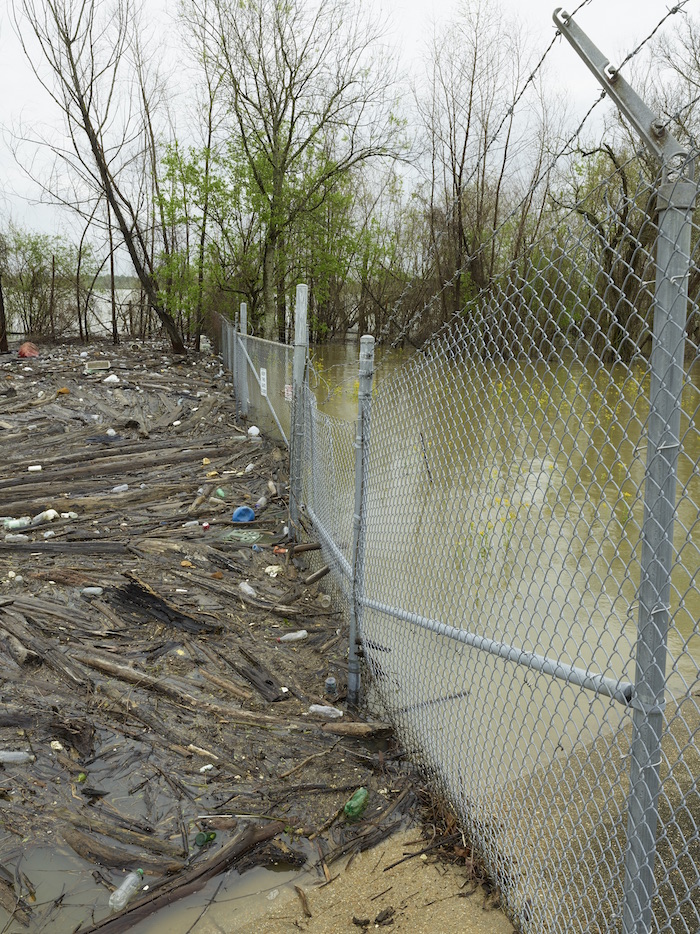
Rahim’s proposed interstate bike trip was simply his latest contribution to what he calls “the struggle for environmental peace and justice.” An African American baby boomer who grew up in the Jim Crow South, Rahim’s experiences in the US military during Vietnam radicalized him and drew him into the Black Power movement. Years later, his work as a public housing tenant organizer and criminal justice critic in the San Francisco Bay Area during the late 1980s and early 1990s led him to join the Green Party. Despite finding himself among a tiny number of Black members in the US party, Rahim remained committed to the Greens into the new millennium. Twice this proponent of armed Black self-defense ran for public office in Louisiana with the Green Party, most notably in a 2008 bid for Congress. Meanwhile, the work of Common Ground, the hurricane relief organization he cofounded, evolved to include toxic soil remediation, wetlands restoration, and community gardening projects alongside its health services, legal clinic, and home rebuilding efforts.
Rahim’s calls for restored wetlands and sustainable, harmonious human development along the Gulf Coast are an extension of a line of Black, southern, working-class concern for the natural world fundamentally tethered to a justice ethic. But, more than that, his underlying utopianism, his belief not just in the possibility of a different world but in the tangible prospect of achieving it, situates him in a Black radical genealogy that is, above all, about imagining “impossible” futures. Malik Rahim’s environmentalism underscores his fervent belief in people’s capacity to change in order to bring a new world into existence. By attending to the places and people who helped form him, we can understand how Rahim arrived at such convictions. What emerges is a portrait of a figure whose environmental activism evolved organically but unevenly out of care for Black southern communities and in solidarity with people, many not Black, sharing commitments to a radically reimagined society. We can see the radical utopianism driving these efforts as well as the limitations that undercut both the vision and its ultimate realization.11
Out of New Orleans
Malik Rahim was born Donald Guyton December 17, 1947, the second of five children in a working-class family. He would be known as Donald or various nicknames until embracing Islam and taking an Arabic name later in life. In a 2006 oral history interview, Rahim praised his parents for the guidance and support they provided five children, especially to him and his two eldest brothers. This despite the fact that all three older Guyton boys would eventually find themselves “caught up in them streets” and end up incarcerated as adults. While his mother, Loubertha Johnson, lived for a time on New Orleans’s East Bank, Rahim was raised across the Mississippi River on the West Bank, in Algiers, and with his grandmother in the adjacent Jefferson Parish city of Gretna.12
As a boy, Rahim’s social consciousness was shaped by his encounters with the racism of these white-dominated West Bank communities. In the late 1950s and early 1960s, African Americans in New Orleans—as elsewhere in the South—remained barred from public recreation facilities designated for whites. He recalls that when he was about eleven, a Black police officer detained him and a group of friends in the back of a police car simply for playing in the playground of the white school one block from Rahim’s home in Algiers. An even more searing incident occurred just a few years later. Rahim remembers Black parents petitioning Gretna city officials for access to a public swimming pool, which they had been denied to that point. After much resistance, according to Rahim, the city eventually acceded to the parents’ demands, not by integrating the existing pool but by building a beautiful brand new pool for “colored” residents—and locating it on the site of a former municipal dump. “I can remember my father told me that he would rather see me swim in a lake of fire before he would allow me to go in that damn pool,” Rahim reflected in 2006. He continued:
I couldn’t understand it. A couple of days after, he sit down and talk[ed] to me about dignity, [then] I understood when I went to that pool and I seen that when the wind shift, the soot that would form on top of it, because it was on a city dump. And when I seen picnic tables and picnic areas that no one would wanna eat at, simply because not only the flies, but the odor.13
For fourteen-year-old Rahim, this was a textbook example of Jim Crow, an assault on his and his community’s sense of self-worth. In hindsight, the siting of the pool would register as something else to the elder Black radical: as a stark, early lesson in environmental racism and the fraught relationship between land use, race, and the well-being of Black communities. Yet the existing historical record of the new pool’s opening suggests a more complicated story than Rahim’s memory of it might allow. In fact, the city had built two new pools, one for African Americans and another larger facility nearby for white residents. According to geographer Richard Campanella, both pools were located near a municipal incinerator, with the white pool in what is now Mel Ott Park actually closer to the pollution source than the Black pool in Gretna Park. Less important than the precise details of location or chronology is the indelible impression these events left on young Rahim, forever shaping his sense of environmental inequality being an integral facet of the broader matrix of injustice.14
Seventeen-year-old Rahim left high school for the Navy and in 1965 was deployed to Vietnam, where his experiences politicized him in important ways. Rahim reacted strongly to the racism he encountered in the service, while the environmental ruin caused by the American military’s widespread use of chemical agents also left a strong imprint on his consciousness. Following his discharge, Rahim settled in California, where he struggled to find steady, well-paying employment. He eventually returned home. At twenty-two, married with two children, he joined the burgeoning Black Panther Party and helped build up its New Orleans chapter, the first to be headquartered in public housing.15
From their base in the Desire projects in the city’s Ninth Ward, the Panthers engaged in political education and tended to the needs of the surrounding poor and working-class Black community underserved by the state. Like their counterparts around the country, the New Orleans Black Panthers operated a children’s free breakfast program and provided free health services (including sickle cell disease screenings). They also instituted neighborhood patrols to ensure residents’ safety. City authorities’ months-long effort to evict the Panthers from the projects led to a shootout on September 15, 1970, between the police and members barricaded inside the Panther headquarters. Miraculously, no one was killed, but a dozen Panthers, including Malik Rahim, were arrested and tried on capital charges. Following the Panthers’ acquittal in the shootout case nearly a year later, Rahim continued his work in the Ninth Ward, even as the group fended off ongoing state repression.16
Disillusioned by what he characterized as the Panthers’ increasing “gangsterism” and collective drift away from their founding principles, Rahim left the Party and New Orleans in the early 1970s and returned to California. During these years, Rahim, too, drifted away from Black radicalism and toward a life in the underground economy. Rahim’s activities eventually landed him in the California prison system, where he spent five years. While inside, he acquired his high school equivalency diploma and determined never to return to the life that had led him behind bars. Upon his release, Rahim moved frequently between California and his native city, maintaining close ties to both places. By the late 1980s, Rahim had settled in the Bay Area, the birthplace of the Black Panthers. In San Francisco, he secured an apartment in public housing and soon found himself organizing his fellow tenants around conditions in their community. Through this work, the onetime Panther and former felon was introduced to the Green Party, which served as a gateway to the next stage in his evolving environmentalism.17
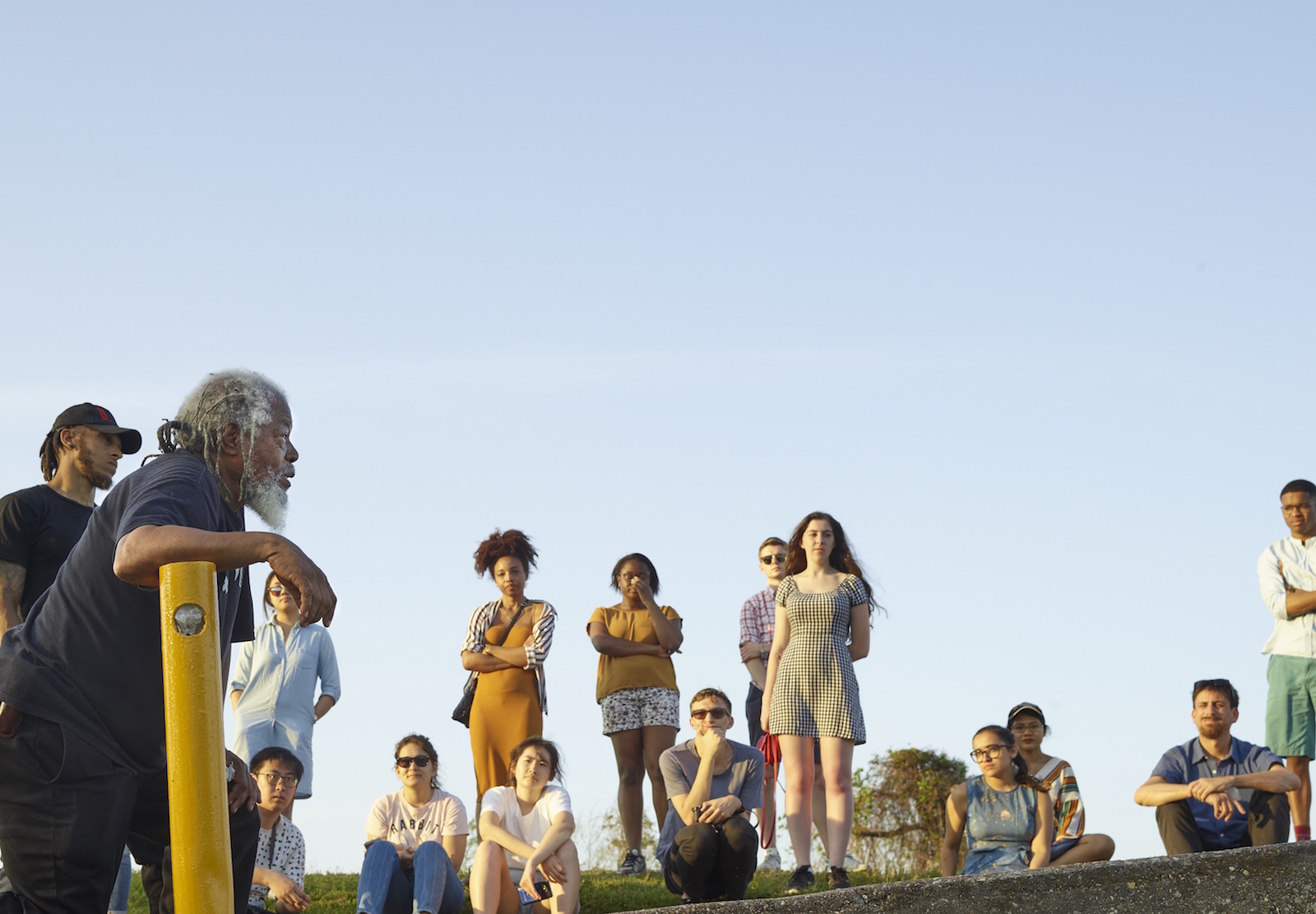
Black Ecology
When Malik Rahim is asked what sparked his commitment to environmental concerns, he cites multiple sources of inspiration. Following his encounters with environmental hazards during his formative years in New Orleans, Rahim’s attention to issues of pollution, environmental toxins, and the holistic ecology of urban Black communities grew in conjunction with his broader politicization. He recalls, for example, that the New Orleans Black Panthers’ wide-ranging work in the Desire housing projects responded directly to residents’ abiding concerns about living conditions in a neighborhood “bordered by railroad tracks, the Mississippi River, the Industrial Canal, and a corridor of industrial plants.” As representatives from the Desire Community Center told a local newspaper in 1970:
We are fighting against the bottom—the crummy building we live in, reeking with the smell of urine, the dirty floors and broken windows, the backyard that’s littered with garbage; the millions of cockroaches crawling over us when we are asleep, sharing our coffee when we are awake; the huge flies and tiny mosquitoes that come through our window, left open in the summer heat so that we can breathe “fresh pollution.”
In response to this reality, the New Orleans Panthers included neighborhood sanitation services, rodent and pest control, and storm-drain cleaning among their programs. These activities not only improved the neighborhood aesthetically, they addressed pressing health concerns. Looking back, Rahim points to what he calls the Panthers’ “whole environmental component” as a key stimulus to his thinking. This was not the conservation movement or lobbying for a stronger regulatory state, but the “environmentalism of the poor.”18
It was precisely such conditions, rampant in neglected urban Black communities across the country, that led sociologist Nathan Hare to urgently articulate a notion of “black ecology” in this very moment. Hare positioned his ecology in direct contrast to the then-dominant forms of white environmentalism, whose preoccupations tended toward “redeeming terrestrial beauty” and pollution’s threat to recreational activities and was largely disconnected from underlying social issues. Hare stressed the spatial qualities of Black life, particularly for city dwellers who experienced overcrowding and substandard housing. “The solutions to the ‘ecological crisis,’” Hare insisted, “are reformist and evasive of the political revolution which black environmental correction demands.” Although there is no evidence that Rahim or his New Orleans Panther comrades read Hare’s essay, the piece is suggestive of the currents of Black radical environmental thought then beginning to circulate.19
In the years after the Panthers’ decline, and following Rahim’s time in prison, several other figures helped shape his nascent environmentalism. There was Father Albert Joseph McKnight, a Black Catholic priest based in Opelousas, Louisiana, who organized Black farmers across the Deep South in cooperatives. Another was Pat Bryant. Bryant, a contemporary of Rahim’s, was the son of sharecroppers and a longtime New Orleanian who had been involved in housing rights and tenant organizing since the civil rights era. By the 1980s, his efforts extended to environmental justice. Bryant focused particularly on the corridor along the Mississippi River between New Orleans and Baton Rouge that activists referred to as “Cancer Alley” for its preponderance of petrochemical plants emitting toxins into the air, soil, and groundwater. In November 1988, Bryant helped lead a protest from the state capital down to New Orleans that organizers dubbed “the Great Louisiana Toxics March.” Rahim pointed to people like Pat Bryant and Father McKnight as encouraging his own attention to environmental issues, saying that they “put it in context for me [as to] why our community was at so much risk.” But perhaps no individual had a greater impact on him in these years than did the Rev. Avery Alexander.20
A stalwart leader in the New Orleans Civil Rights Movement, Alexander was one of Rahim’s heroes. Alexander was an original member of Dr. Martin Luther King Jr.’s Southern Christian Leadership Council (SCLC) who participated in downtown desegregation pickets and was once famously dragged by police up the New Orleans City Hall stairs by his ankles, his head bouncing on the stone steps, while protesting the segregation of the municipal cafeteria. In 1975, Rev. Alexander was elected to the Louisiana state legislature, where he continued to champion civil and human rights until his death in 1999.21
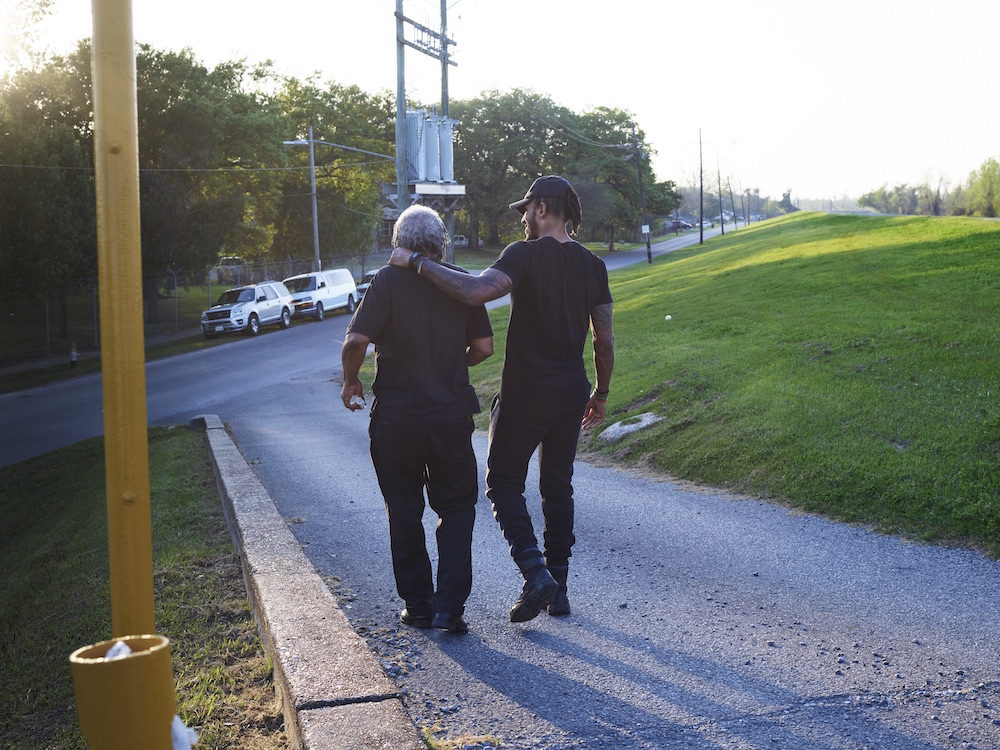
Rahim credits Alexander with persuading him to prioritize environmental issues in the 1980s. Alexander’s message was that if organizers like Rahim didn’t turn their attention to the fundamental issues of clean water, air, and soil—that is, to addressing the basic needs of people to sustain themselves and live—then any effort to tackle more narrowly conceived questions of community safety, security, and citizenship would be moot. Rahim declares, “I had been into the environmental movement ever since I had first met the Reverend Avery Alexander. … He’s the one who opened it up to me about our community.”22
Despite counting several women among his most respected and trusted comrades in the New Orleans Panthers, Rahim does not cite any Black women activists among his key environmentalist influences. This is significant because both anecdotal and scholarly accounts suggest that Black (and other nonwhite) women are equally, and by some measures more, concerned about environmental issues as their male counterparts. Indeed, Black women have played a leading role in Black environmentalism in Louisiana over the past forty years. They have, for example, been at the forefront of local struggles against the petrochemical industry and the disparate impact of toxins on nearby Black communities, whether in the southwest part of the state or along Cancer Alley. While in the years after Katrina Rahim became more connected to Black environmentalist efforts in the region, and those formations and organization spearheaded by Black women, it is evident that his strongest early influences in this regard were male activists of his generation or older.23
Yet if Black southern male activists like Father McKnight, Pat Bryant, and Rev. Alexander stoked Rahim’s attentiveness to environmental issues and invited him to look at his world through another lens, it was his encounter with the Green Party that sharpened his analysis. Rahim’s introduction to the Greens came while he was organizing public housing tenants in San Francisco in the early 1990s. He remembers being handed a Green Party flier one day while riding the bus. The flier advertised a gathering to discuss Hunters Point, a historically African American neighborhood in San Francisco that was at once a locus of accelerating gentrification and home to a decommissioned naval shipyard turned radioactive Superfund site. His interest sufficiently piqued, Rahim attended the meeting.24
He made a point to arrive early, giving himself time to observe the crowd, but nearly left before the program began. “By the time the meeting started, it must have been about, I would say, about twenty people there,” he remembered. “But I was the only Black. And then, most everybody else had—was college educated, you know? Just about everybody there had degrees except me.” In that moment Rahim, the formerly incarcerated Black Panther and Vietnam veteran who had earned his GED as an adult behind bars, saw only the gulf of experience between himself and the ostensibly environmentally-oriented progressives surrounding him. But “before I could leave,” he continued, “the conversation came up of all the environmental issues that we was facing in San Francisco. And it was just like somebody had grabbed me and turned me around, you know? I went back. I sat. I listened.” Not only did he stay through the end of the meeting, Rahim soon changed his voter registration and officially joined the Greens, beginning a lifelong affiliation. It was a political relationship that would help refine his environmental analysis, expand his internationalism, and facilitate two important runs for public office in his hometown.25
At the time Rahim first got involved, the Green Party in the United States was not yet a national political organization but rather a loosely affiliated collection of local groups, regional confederations, and burgeoning state parties. Although the Hunters Point issues are what initially attracted Rahim, the Greens’ support for broad-based “equality” and the “awareness of what we was doing to this planet” are what most resonated with him. What united the multiple and diverse Green formations, nationally and globally, was allegiance to a set of shared principles, commonly referred to as the “Ten Key Values.” These principles included commitments to social and economic justice, grassroots democracy, decentralization (of both power and resources), feminism, ecological wisdom, and future planning and sustainability. These pillars resonated with Rahim’s own political ideas, which had been shaped by his experiences in the Panthers and after. And they are what kept him working with the group even as he “remained the only working-class African American … that was Green,” at least in Hunters Point (and perhaps in greater San Francisco) in those years.26
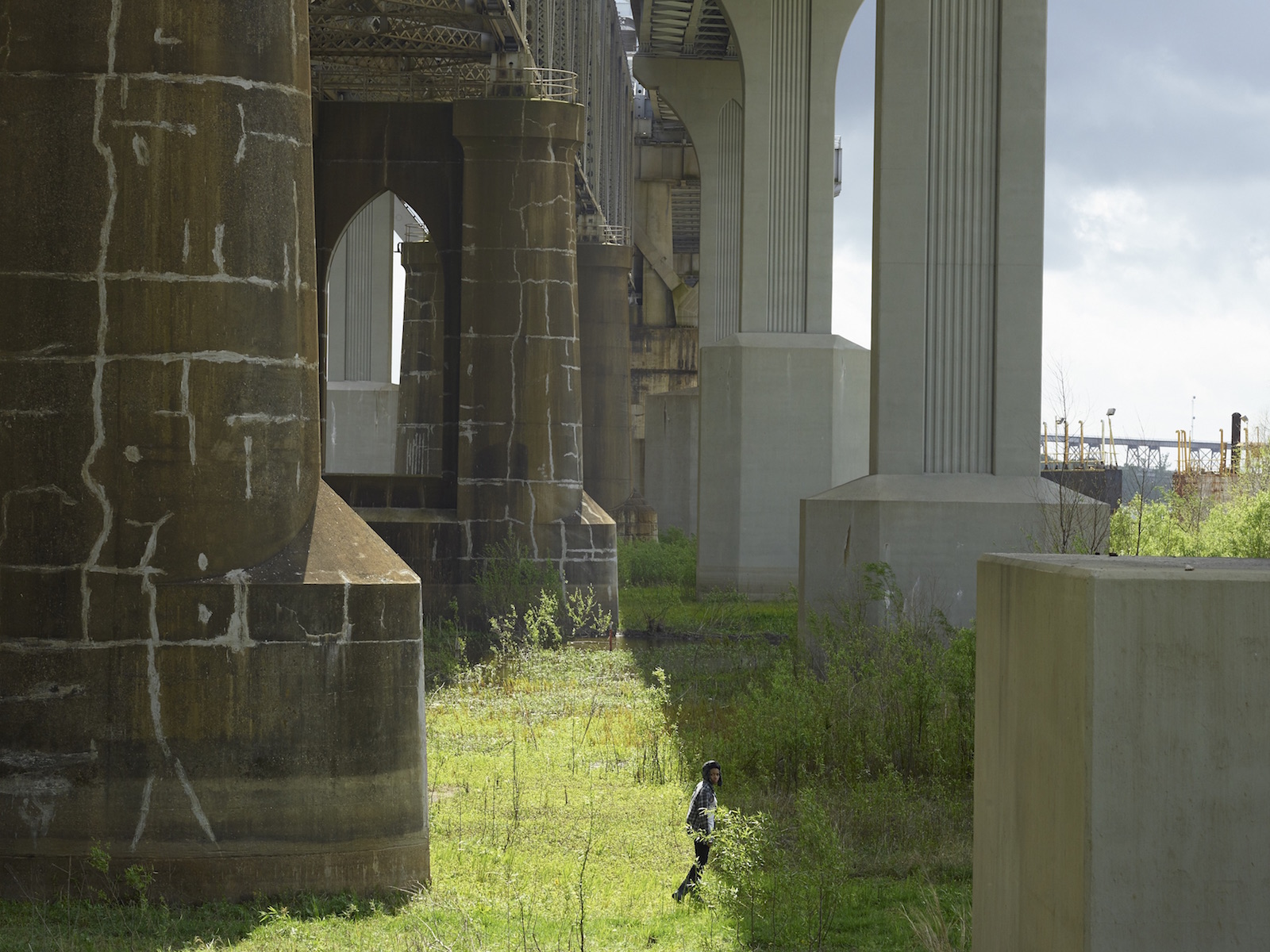
Rahim carried his Green commitments with him when he returned to New Orleans from the Bay Area. In 2002, three decades after his involvement in the Desire shootout with New Orleans police, Rahim ran for city council as a Green Party candidate. His campaign flier was equal parts candidate biography and introduction to the party and its tenets. Without naming specific environmental issues, the poster enumerated the Greens’ key values, communicating a robust social justice vision of which environmentalism was an essential component. While Rahim fell well short of the needed votes, his candidacy set an important precedent. Six years later, he would mount an even more ambitious political campaign, challenging a popular Black Democratic incumbent for Congress. But in the intervening years, both Rahim and his city would be irreversibly transformed by the events of Hurricane Katrina.27
Solidarity Not Charity
In early September 2005, just days after the catastrophic levee failures that left most of New Orleans submerged, Rahim sat at his kitchen table in Algiers with his then-partner, Sharon Johnson, former Panther and longtime political prisoner Robert King, and two white anarchist activists from Texas, scott crow and Brandon Darby. Darby and crow had traveled from Austin to New Orleans—by then under mandatory evacuation orders and a military occupation—to try to rescue King, who had been trapped in his flooded house. Following the successful rescue, the group convened at Rahim’s home on the mostly dry ground of the West Bank to assess the crisis and the calamitous failures of government. Determined to do something, they pooled fifty dollars and formed a new mutual aid and relief organization, which they dubbed Common Ground. Robert King soon returned to Texas but the others remained and began to build up the group with the help of volunteers they recruited.28
Using Rahim’s house as a base of operations, and having to protect themselves against armed white vigilantes determined to keep Black people out of the area, the nascent collective began providing water and basic supplies to desperate residents who had ridden out the storm. Rahim activated his networks, from the Green Party to antiwar groups like Veterans for Peace, and put out a call for volunteers to come to New Orleans. The organization’s motto was “solidarity not charity.” This was crucial because the vast majority of volunteers the group attracted—initially a handful, then scores, and within two months several hundreds—were outsiders, almost all of them white. Rahim quickly realized that the volunteers’ white skin privilege gave them certain advantages of mobility under the prevailing conditions of martial law, allowing them to pass checkpoints and transfer supplies in ways that were nearly impossible for their Black and Latinx counterparts.29
At the same time, drawing on the example of the Panthers, it was imperative that volunteers understood their relief work as part of a common struggle with the people of New Orleans, not an act of simple benevolence. The group’s success in this regard was, at best, uneven. Common Ground generally, and to some extent Rahim individually, came under extensive criticism for the group’s racial politics and for perceptions of racial paternalism among some volunteers. Some of this critique was launched by Black New Orleanians and experienced organizers associated with other groups, most prominently the People’s Hurricane Relief Fund (PHRF) coalition.30
Common Ground expanded rapidly in Katrina’s aftermath. At the outset, its main function was to provide clean water, food, and basic supplies to those ignored by the Federal Emergency Management Agency (FEMA) and the Red Cross. Volunteers were housed in an abandoned Catholic school. On the site of Rahim’s former mosque in Algiers, Common Ground set up a makeshift health clinic, before it later moved to its own building. Within a month, as one journalist recounts, “Common Ground had a distribution network bringing food and supplies to sixteen thousand people in the area and a free health clinic serving hundreds of patients, many of whom had not seen a doctor in years, even decades.”31
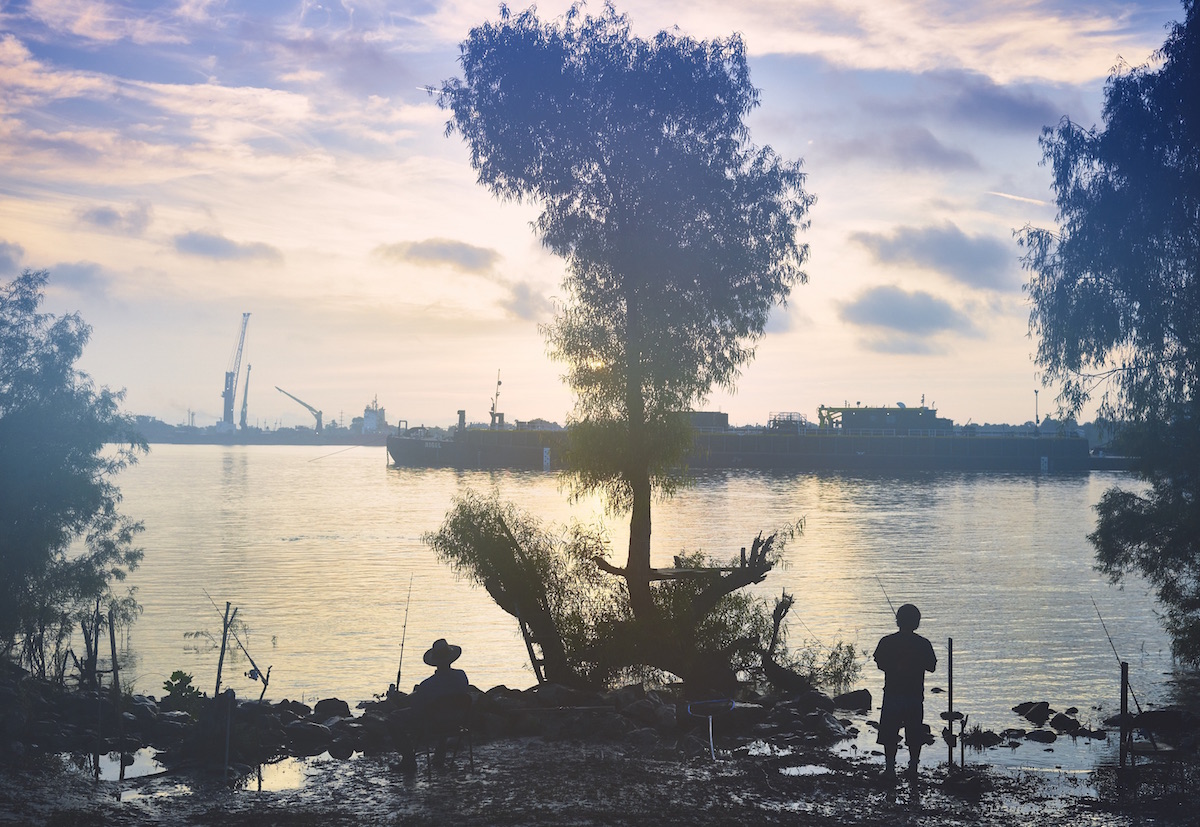
The group’s infrastructure and the service projects multiplied: gutting homes; repairing roofs; a newsletter; a legal clinic; and advocacy toward the reopening of a neighborhood school in the Lower Ninth Ward. Within two years, the health clinic had grown to such a degree that it became a standalone organization with its own leadership and paid staff.32
Common Ground’s environmental work began taking shape in the months after the flood as the organization, and New Orleanians more broadly, confronted the breadth of Katrina’s ecological impact. Over time, Common Ground’s initiatives included mold remediation in flooded houses, neighborhood gardens, solar showers, and composting toilets. Some of these projects were small-scale, while others reflected a much greater ambition. For example, the group developed a bio-remediation program that used various plants and fungi to help extract toxic sediments from the local soil and a wetland restoration project growing marsh grasses and hardwood trees to be planted in fragile coastal bayous.33
To be clear, Malik Rahim was not solely responsible for this broad spectrum of activity. On the contrary, Rahim credits veteran social justice activist Lisa Fithian for further crystalizing his own environmentalism in these years and for focusing Common Ground’s environmental work. Similarly, scott crow identifies several other volunteers who contributed to specific aspects of Common Ground’s environmental program. But as the organization’s public face and chief fundraiser, Rahim played a critical role in articulating the significance and necessity of the group’s work in this realm. Ultimately, the wide range of these initiatives reflected not only the breadth of need and the work of a diverse array of activists and volunteers, but Rahim’s own vision for urban regeneration.34
The success of Common Ground in the absence of any government support is a testament to many factors, but among these is Rahim’s faith in human capacity, his wealth of organizing experience, and his deep commitment to a more just, sustainable New Orleans. Despite the overwhelming failures of government to perform the most basic functions of protecting and aiding its citizens, a year after Katrina Rahim remained open to the possibilities of government-community collaboration. His personal antipathies toward New Orleans mayor Ray Nagin, Louisiana governor Kathleen Blanco, FEMA, and the rest did not override his willingness to work with any group for the greater good. “If the city would give us the facility and just help us by making sure that the basics—electrical, gas, water—is being supplied there, we could develop enough of this bacteria tea that we make that we could clean this whole damn city. And clean it to a level greater than it was during pre-Katrina. We could develop that, working together.”35
In the fall of 2008, while another one-time community organizer vied for the White House, Malik Rahim challenged the two-party duopoly by running as a Green for the congressional seat then occupied by African American Democrat William Jefferson, then indicted for corruption. To some it was a surprising move, but his choice to enter the race sat comfortably in the trajectory of his activist life. Rahim saw no contradiction between his organizing efforts and a bid for elected office, just as he saw no conflict between the work of racial justice and the environmental movement. He had been involved with the Green Party since the early 1990s, and had run for office once before.36
In an email announcing his candidacy, Rahim framed his choice this way: “Four days after Hurricane Katrina and two days before founding Common Ground, I made this decision to run for Congress. This decision was made due to the lack of government response to Katrina. My hope is that never again will any disaster turn into such a tragedy.” That summer, Rahim delivered a keynote address to the Green Party national convention in Chicago, declaring:
I’ve been in the green movement now seventeen years. I’ve seen a lot of ups and a lot of downs. I’ve seen many agreements and many disagreements, but we have persevered. We have survived the time when to be called “green” was to be called a kook, but now we are living in a green movement. Individuals who would never say anything about green are now building green. People are now talking about manufacturing biodiesel [and] solar panels, converting organic matter as it decomposes into gas and using that gas to produce energy. To many people, this is new, but I can remember hearing the same thing seventeen years ago. But we must continue. We must be the future.
Rahim had neither the experience, the staff, nor the resources to mount a full-scale congressional campaign, least of all as a third-party candidate. With the incumbent under federal indictment, Vietnamese American Republican Joseph Cao went on to win the election that November.37
Rahim’s 2008 candidacy offered inspiration, highlighting urgent intersections between racial, economic, and environmental justice. Yet it left unanswered questions regarding the commitment of the majority-white Green Party to engaging, and forging meaningful relationships, with the working-class Black New Orleanians who formed the district’s backbone. In this way, Rahim’s run for Congress—like his work with Common Ground—underscored the challenges of pursuing Black radical environmentalist politics in the twenty-first century. Specifically, Rahim’s experiences point to the difficulty of using multiracial organizing spaces to directly address the needs of vulnerable Black communities facing environmental threat.
Living Within Nature
Educated in the streets, in prison, and in the struggle, Malik Rahim is not much for theory. His ideas about community empowerment, social justice, and environmental innovation are born out of praxis. They knit together strands of the Black radical tradition with the American environmental movement, the peace movement, and a utopian humanism. They reflect his experiences as a working-class Black southerner who came of age under Jim Crow, and developed an analysis of racism and imperialism from inside the American military and as a member of the Black Panther Party. Rahim became an environmentalist because, not in spite, of these experiences.
In the spring after Katrina, less than a year after the floodwaters had receded, Malik Rahim looked at his city’s prospects for recovery, considered what Common Ground had accomplished, and with stubborn optimism imagined a more sustainable future:
I could see this city having a storm protection system that’s gonna be the marvel of the world. … I could see us restoring our wetland. I could see that if we would come together right now, by 2050 that half of the wetlands that we have lost are be restored. And [we’ll be] on our way to restoring the other half. . . . I could see our kids enjoying the wetlands like our forefathers enjoyed ’em. I could see this being the most environmentally friendly [city].
With the hindsight of fifteen years, in the context of the failures of political leadership to substantively address the underlying crises the Katrina disaster laid bare, and with further environmental destruction inevitably ahead, it would be easy to dismiss Rahim’s dream as tragically naïve or unrealistic. But the long history of Black struggle with which Rahim so deeply identifies invites, even requires, this kind of fantastical imagining. For Rahim, as for other Black radical environmentalists, this means daring to imagine at once a more just and equitable organization of society and a different relationship between people and the world they inhabit. “We cannot prevent nature from taking its course,” Rahim observes. “So we gonna live within nature.”38
This essay first appeared in the Human/Nature Issue (vol. 27, no. 2: Spring 2021).
Joshua B. Guild is associate professor of history and African American studies at Princeton University. He is working on a book about Black activism and struggles for racial and economic justice in New Orleans from the mid-twentieth century to the present.
Header image: Aquapride, Lower Algiers Levee, New Orleans, 2016.
The author is grateful for the assistance of the journal’s editors, anonymous reviewers, and especially the issue’s guest editor, Andy Horowitz, as well as for the visual contributions of Jeff Whetstone. The author also wishes to acknowledge Malik Rahim for his trust, patience, and generosity over many years.
- Meg Perry Center for Environmental Peace and Justice, press release, July 7, 2010; FluxRostrum, “Bike for the Gulf with Malik Rahim,” June 23, 2010, YouTube video, 6:05, https://www.youtube.com/watch?v=xmzq8KkeZZI; Brentin Mock, “The Root Interview: Malik Rahim,” July 15, 2010, http://www.theroot.com/views/root-interview-malik-rahim; “Bike Ride to Save the Gulf,” June 21, 2010, in Evening News, produced by KBOO, 2:43, https://www.kboo.fm/media/9611-bike-ridesave-gulf. On April 20, 2010, less than a month after the Obama administration relaxed offshore drilling regulations, the BP oil rig Deepwater Horizon exploded and eventually sank in the Gulf of Mexico while drilling at the Macondo Prospect, some forty-one miles off the coast of Louisiana. Eleven workers aboard died as a result of the explosion, which initiated “the largest spill of oil in the history of marine oil drilling operations,” according to the Environmental Protection Agency (EPA). The spill released some four million barrels of oil into the Gulf over an eight-seven-day period, prior to being capped in mid-July. United States Environmental Protection Agency, Enforcement Division, “Deepwater Horizon – BP Gulf of Mexico Oil Spill,” accessed June 12, 2020, https://www.epa.gov/enforcement/deepwater-horizon-bp-gulf-mexico-oil-spill. See also National Commission on the BP Deepwater Horizon Oil Spill and Offshore Drilling, Deep Water: The Gulf Oil Disaster and the Future of Offshore Drilling, Report to the President, January 2011, https://www.govinfo.gov/content/pkg/GPO-OILCOMMISSION/pdf/GPO-OILCOMMISSION.pdf; and Suzanne Goldenberg, “Barack Obama Reverses Campaign Promise and Approves Offshore Drilling,” Guardian, March 31, 2010, https://www.theguardian.com/world/2010/mar/31/barackobama-drilling-offshore-approves.
- Kate Galbraith, “Environmentalists Use Oil Spill as a Rallying Cry,” New York Times, June 13, 2010, https://www.nytimes.com/2010/06/14/business/energy-environment/14green.html; “Greenpeace Activists Scale BP’s London Headquarters in Oil Protest,” Guardian, May 20, 2010, https://www.theguardian.com/environment/2010/may/20/greenpeace-activists-scale-bp-building-roof; “7 Greenpeace Activists Arrested in Anti-Drilling Protest,” CNN, May 24, 2010, http://www.cnn.com/2010/US/05/24/us.gulf.oil.greenpeace.arrests/index.html; Melissa K. Merry, Framing Environmental Disaster: Environmental Advocacy and the Deepwater Horizon Oil Spill (New York: Routledge, 2014).
- J. T. Roane and Justin Hosbey, “Mapping Black Ecologies,” Current Research in Digital History, vol. 2 (2019), https://doi.org/10.31835/crdh.2019.05; Kimberly N. Ruffin, Black on Earth: African American Ecoliterary Traditions (Athens: University of Georgia Press, 2010), 2–3.
- See, for example, Paul Mohai, David Pellow, and J. Timmons Roberts, “Environmental Justice,” Annual Review of Environmental Resources 34 (July 2009): 405–430.
- David N. Pellow, “Towards a Critical Environmental Justice Studies: Black Lives Matter as an Environmental Justice Challenge,” Du Bois Review 13, no. 2 (Fall 2016): 221–236; David N. Pellow, “Political Prisoners and Environmental Justice,” Capitalism Nature Socialism 29, no. 4 (November 2018): 1–20; Laura Pulido, “Conversations in Environmental Justice: An Interview with David Pellow,” Capitalism Nature Socialism 28, no. 2 (April 2017): 43–53; Laura Pulido and Juan De Lara, “Reimagining ‘Justice’ in Environmental Justice: Radical Ecologies, Decolonial Thought, and the Black Radical Tradition,” Environment and Planning E: Nature and Space 1, no. 1/2 (2018): 76–98; Ruth Wilson Gilmore, “Fatal Couplings of Power and Difference: Notes on Racism and Geography,” Professional Geographer 54, no. 1 (February 2002): 15–24. Robert D. Bullard, Dumping in Dixie: Race, Class, and Environmental Quality, 3rd ed. (Boulder, CO: Westview Press, 2000); Dorceta E. Taylor, “Race, Class, Gender, and American Environmentalism” (Portland, OR: US Department of Agriculture, Forest Service, Pacific Northwest Research Station, 2002), Gen. Tech. Rep. PNW-GTR-534; Michael Egan, “Subaltern Environmentalism in the United States: A Historiographic Review,” Environment and History 8, no. 1 (February 2002): 21–41; Brentin Mock, “Are There Two Different Versions of Environmentalism, One ‘White,’ One ‘Black’?,” Mother Jones, July 31, 2014, https://www.motherjones.com/environment/2014/07/white-black-environmentalism-racism/. On the postwar evolution of the American environmental movement, see Steven Stoll, U.S. Environmentalism since 1945: A Brief History with Documents (New York: Palgrave Macmillan, 2007). See Nathan Hare, “Black Ecology,” Black Scholar 1 (April 1970): 2–8. Two decades later, Paul Mohai’s important early study on Black and white Americans’ purported differing attitudes about environmental issues challenged prevailing notions that Blacks cared less about environmental issues than their white counterparts. Paul Mohai, “Black Environmentalism,” Social Science Quarterly 71, no. 4 (December 1990): 744–765.
- Andy Horowitz, Katrina: A History, 1915–2015 (Cambridge, MA: Harvard University Press, 2020), chap. 3; Bob Marshall, The Lens, Brian Jacobs, and Al Shaw, “Losing Ground,” ProPublica, August 28, 2014, https://projects.propublica.org/louisiana/; John M. Barry, “Suing Exxon—and the Future of New Orleans,” accessed June 22, 2020, http://www.johnmbarry.com/bio.htm; FluxRostrum, “Bike for the Gulf.” On Hurricane Katrina and the disaster of recovery, see Horowitz, Katrina; Clyde A. Woods, Development Drowned and Reborn: The Blues and Bourbon Restorations in Post-Katrina New Orleans, ed. Jordan T. Camp and Laura Pulido (Athens: University of Georgia Press, 2017); Gary Rivlin, Katrina: After the Flood (New York: Simon & Schuster, 2015); Vincanne Adams, Markets of Sorrow, Labors of Faith: New Orleans in the Wake of Katrina (Durham, NC: Duke University Press, 2013); Cedric Johnson, ed., The Neoliberal Deluge: Hurricane Katrina, Late Capitalism, and the Remaking of New Orleans (Minneapolis: University of Minnesota Press, 2011); Jordan Flaherty, Floodlines: Community and Resistance from Katrina to the Jena Six (Chicago: Haymarket Books, 2010); Manning Marable and Kristen Clarke, eds., Seeking Higher Ground: The Hurricane Katrina Crisis, Race, and Public Policy Reader (New York: Palgrave Macmillan, 2008); Billy Sothern, Down in New Orleans: Reflections from a Drowned City, 1st ed. (Berkeley: University of California Press, 2007); and The South End Press Collective, ed., What Lies Beneath: Katrina, Race, and the State of the Nation (Boston: South End Press, 2006).
- “Malik Rahim on His Upcoming Bike Tour from New Orleans to DC,” interview by KBOO Radio, June 19, 2010, in A-Infos Radio Project, MP3 audio, 14:12, http://www.radio4all.net/index.php/program/43568.
- Rahm Emanuel, “Rahm Emanuel on the Opportunities of Crisis,” Wall Street Journal, November 19, 2008, YouTube video, 2:47, https://www.youtube.com/watch?v=_mzcbXi1Tkk; Naomi Klein, The Shock Doctrine: The Rise of Disaster Capitalism (New York: Metropolitan Books/Henry Holt, 2007); Arundhati Roy, “Arundhati Roy: ‘The Pandemic Is a Portal,’” Financial Times, April 3, 2020, https://www.ft.com/content/10d8f5e8-74eb-11ea-95fe-fcd274e920ca.
- Mock, “Root Interview.”
- Robin D. G. Kelley, Freedom Dreams: The Black Radical Imagination (Boston: Beacon Press, 2002). On Black geographies and radical placemaking practices, see Katherine McKittrick, Demonic Grounds: Black Women and the Cartographies of Struggle (Minneapolis: University of Minnesota Press, 2006); Katherine McKittrick and Clyde Woods, eds., Black Geographies and the Politics of Place (Toronto: Between the Lines Press, 2007); and Ruth Wilson Gilmore, “Abolition Geography and the Problem of Innocence,” in The Futures of Black Radicalism, ed. Gaye Theresa Johnson and Alex Lubin (New York: Verso, 2017), 225–240.
- The notion of bringing a new world into existence is captured by the formulation of “otherwise” worlds, which I borrow from thinkers such as Saidiya Hartman, Ruth Wilson Gilmore, Robin D. G. Kelley, and Ashon Crawley (among many others), who write about and within the Black radical tradition as enunciated by Cedric J. Robinson in his landmark 1983 text Black Marxism: The Making of the Black Radical Tradition (Chapel Hill: University of North Carolina Press, 2000).
- Rahim called his father “one of the greatest men that I knew” and his mother “the essence of love.” Rahim’s mother remarried in his adolescence. Rahim commended his stepfather for helping stabilize the family and fully “accept[ing] us and rais[ing] us.” Malik Rahim, interview by Pamela Hamilton, May 23, 2006, Southern Oral History Program Collection (#4007), Interview U-0252 (hereafter cited as Rahim, SOHP interview).
- Malik Rahim, interviewed by the author, July 26, 2011, New Orleans, LA; Rahim, SOHP interview.
- Richard Campanella, The West Bank of Greater New Orleans: A Historical Geography (Baton Rouge: Louisiana State University Press, 2020), 213–214. While the white pool was actually nearer to the incinerator, the question of whether the pool for African Americans was built on land once used as a dump remains open. Richard Campanella, email message to author, June 21, 2020.
- Before its official recognition as a BPP chapter in mid-1970, the group was known as the National Committee to Combat Facism (NCCF). Orissa Arend, Showdown in Desire: The Black Panthers Take a Stand in New Orleans (Fayetteville: University of Arkansas Press, 2009); Orissa Arend and Judson L. Jeffries, “The Big Easy Was Anything But for the Panthers,” in On the Ground: The Black Panther Party in Communities across America, ed. Judson L. Jeffries (Jackson: University Press of Mississippi, 2010), 224–272.
- Alondra Nelson, Body and Soul: The Black Panther Party and the Fight against Medical Discrimination (Minneapolis: University of Minnesota Press, 2013); Arend, Showdown in Desire.
- Malik Rahim, interviewed by the author, September 11, 2018, New Orleans, LA.
- Arend and Jeffries, “The Big Easy Was Anything But,” 227; Gene Bourg, “Desire Project Incubator for Crime, Report Says,” New Orleans States-Item, September 15, 1970, quoted in Arend and Jeffries, “The Big Easy Was Anything But,” 227; Malik Rahim, interviewed by the author, July 27, 2012, New Orleans, LA; Rob Nixon, Slow Violence and the Environmentalism of the Poor (Cambridge, MA: Harvard University Press, 2011).
- Hare, “Black Ecology,” esp. 2.
- Malik Rahim, interviewed by the author, February 23, 2018, New Orleans, LA.; Jordan Arceneaux, “Former Holy Ghost Pastor Dies at 88,” Opelousas Daily World, April 18, 2016, https://www.dailyworld.com/story/news/local/2016/04/18/former-holy-ghost-pastor-dies-88/83186212/; Luna Reyna, “Black Lives Matter: Don’t Forget the SLOW Deaths from Toxic Pollution,” Red Green and Blue, June 4, 2020, https://redgreenandblue.org/2020/06/04/black-lives-matter-dont-forget-slow-deaths-toxic-pollution/; Mary T. Schmich, “They March to Clean Up a State’s Act,” Chicago Tribune, November 20, 1988, https://www.chicagotribune.com/news/ct-xpm-1988-11-20-8802170889-story.html.
- Kim Lacy Rogers, Righteous Lives: Narratives of the New Orleans Civil Rights Movement (New York: New York University Press, 1993), 92–93; Adam Fairclough, Race & Democracy: The Civil Struggle in Louisiana, 1915–1972, 2nd ed. (Athens: University of Georgia Press, 2008).
- Rahim, interview, February 23, 2018.
- William Arp III and Christopher Howell, “Black Environmentalism and Gender Differences: An Ethics of Care?,” Western Journal of Black Studies 19, no. 4 (Winter 1995): 300–305. See Steve Lerner, Diamond: A Struggle for Environmental Justice in Louisiana’s Chemical Corridor (Cambridge, MA: MIT Press, 2005); Revathi I. Hines, “The Price of Pollution: The Struggle for Environmental Justice in Mossville, Louisiana,” Western Journal of Black Studies 39, no. 3 (Fall 2015): 198–208; and Richard A. Webster, “The Poisoned Promises of Agriculture Street,” NOLA.com/The Times-Picayune, April 22, 2015, https://www.nola.com/news/politics/article_18f4b255-eeb1-56af-8fe2-874edf331d3f.html.
- United States Environmental Protection Agency, “Superfund Site Progress Profile: Treasure Island Naval Station-Hunters Point Annex,” last modified June 15, 2011, https://web.archive.org/web/20110616054426/http://cfpub.epa.gov/supercpad/cursites/csitinfo.cfm?id=0902722.
- Rahim, interview, July 27, 2012.
- Rahim, interview, July 27, 2012. The key values formed the basis for the original Committees of Correspondence in 1984 and would be adopted and revised by subsequent Green Party organizations over the next two decades. Jodean Marks, “A Historical Look at Green Structure: 1984 to 1992,” Synthesis/Regeneration 14 (Fall 1997): http://www.greens.org/s-r/14/14-03.html; and Greens, “The Ten Key Values of the Greens,” accessed July 24, 2020, http://www.greens.org/values/. Drawing inspiration from Green parties and movements in Western Europe, the Greens began in the United States in 1984 as the Committees of Correspondence (CoC). Marks, “Green Structure.”
- “Malik Rahim: Green Party Candidate for City Council At-Large,” It’s About Time, accessed July 24, 2020, http://www.itsabouttimebpp.com/Chapter_History/New_Orleans_Malik_Rahim.html.
- Rahim, SOHP interview. Cycling in and out of jail as a young man, King was convicted of robbery in 1970 and sentenced to thirty-five years. While inside, he encountered the New Orleans Black Panthers, including Rahim, who had been arrested in the Desire police shootout. King would eventually become a party member himself and, along with two comrades, Herman Wallace and Albert Woodfox, formed a Black Panther Party chapter in Louisiana’s notorious Angola Prison. Targeted by prison officials for their political activities, the three would each be convicted of murder behind bars on the basis of false evidence, and would spend decades in solitary confinement as a result while they contested their convictions. Starting in the mid-1990s, Rahim helped publicize and cultivate support for the “Angola Three.” King won his release in 2001. crow and Darby befriended King in Austin, where he had settled. Robert Hillary King, From the Bottom of the Heap: The Autobiography of Black Panther Robert Hillary King (Oakland, CA: PM Press, 2012); scott crow, Black Flags and Windmills: Hope, Anarchy, and the Common Ground Collective (Oakland, CA: PM Press, 2011); Albert Woodfox, Solitary: Unbroken by Four Decades in Solitary Confinement. My Story of Transformation and Hope (New York: Grove Press, 2019).
- crow, Black Flags and Windmills, 47–67.
- Flaherty, Floodlines, 94–98; Sothern, Down in New Orleans, 273–285.
- Flaherty, Floodlines, 99.
- Flaherty, Floodlines, 100.
- crow, Black Flags and Windmills, 154–156.
- Malik Rahim, conversation with the author, October 28, 2014, New Orleans, LA. See also Lisa Fithian, Shut It Down: Stories from a Fierce, Loving Resistance (White River Junction, VT: Chelsea Green Publishing, 2019).
- Rahim, SOHP interview. Some would point to the willingness to work with government as Common Ground and Rahim’s tacit adoption of a neoliberal agenda, a charge that both flattens the complexity of the organization’s influences and misunderstands the nature of Rahim’s politics. See John Arena, “Black and White, Unite and Fight? Identity Politics and New Orleans’s Post-Katrina Public Housing Movement” in The Neoliberal Deluge: Hurricane Katrina, Late Capitalism, and the Remaking of New Orleans, ed. Cedric Johnson (Minneapolis: University of Minnesota Press, 2011), 158–184. Rahim’s faith in humanity and his reputation as an organizer were severely tested at the end of 2008 when Common Ground cofounder Brandon Darby publicly revealed himself to have been an FBI informant. Many in Common Ground had expressed reservations to Rahim about Darby’s behavior at different points over the years, but Rahim had chosen not to act on those suspicions and was shattered by the revelations. See Colin Moynihan, “Activist Unmasks Himself as Federal Informant in G.O.P. Convention Case,” New York Times, January 4, 2009, https://www.nytimes.com/2009/01/05/us/05informant.html; Austin Informant Working Group, “Common Ground Co-Founder Brandon Darby Admits to Role as FBI Informant (at RNC ’08 and More),” Santa Cruz Indymedia Center, January 2, 2009, https://www.indybay.org/newsitems/2009/01/02/18557859.php; Kristian Williams, “Witness to Betrayal: scott crow on the Exploits and Misadventures of FBI Informant Brandon Darby,” Earth First!, December 20, 2013, https://earthfirstjournal.org/newswire/2013/12/20/witness-to-betrayalscott-crow-on-the-exploits-and-misadventures-of-fbi-informant-brandon-darby/.
- Michelle Krupa and Frank Donze, “Two Candidates Offer Alternative Views,” New Orleans Times-Picayune, December 2, 2008, 6.
- Rahim, quoted in “Malik Rahim for Congress Dec. 6!,” San Francisco Bayview, November 22, 2008; Malik Rahim, speech, 2008 Green Party National Convention, Chicago, IL, July 2008 (transcript in author’s possession).
- Rahim, SOHP interview.

